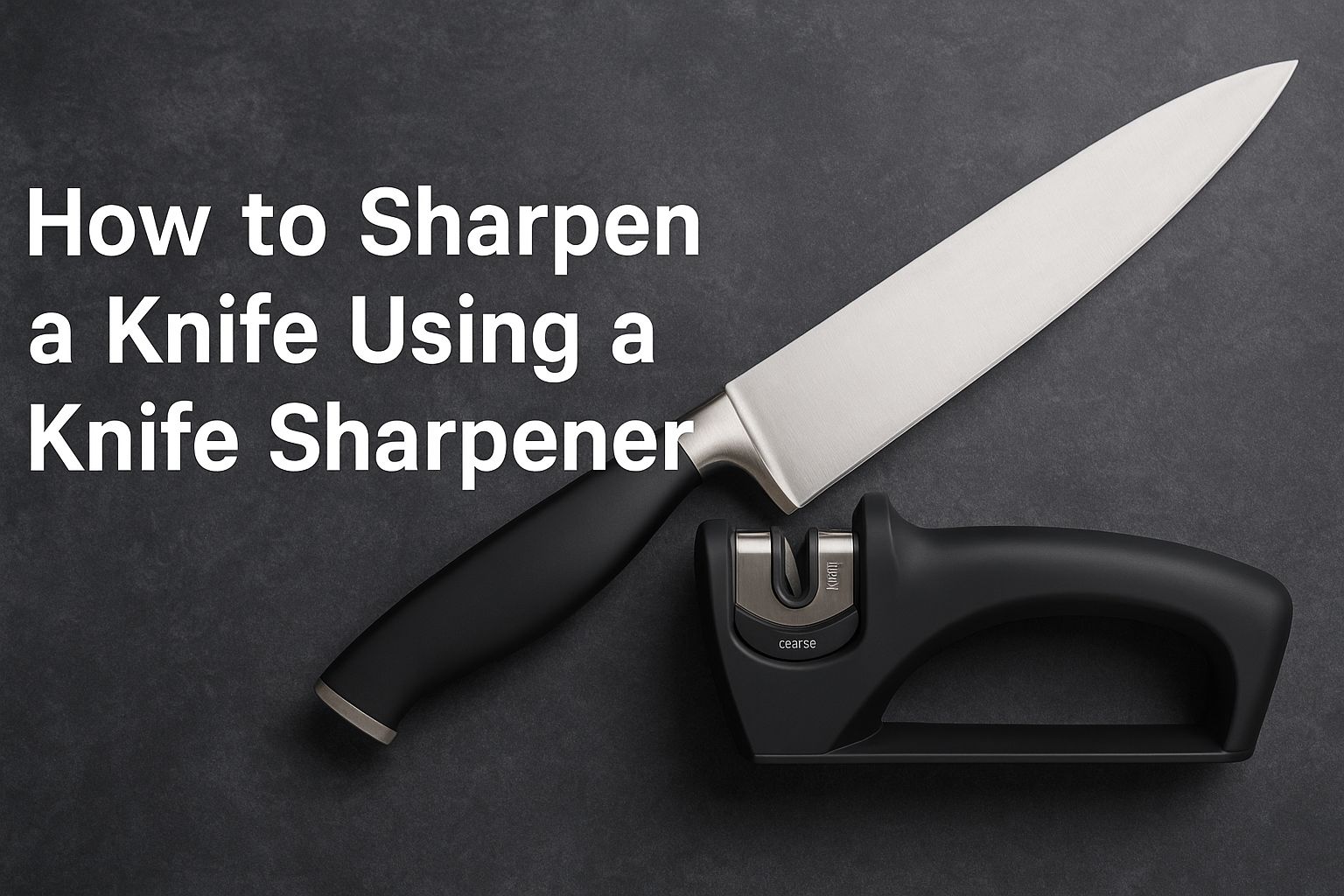A sharp knife is the unsung hero of every kitchen. Whether you’re dicing onions, slicing meat, or carving a roast, a sharp blade ensures precision, speed, and safety. However, even the best knives dull over time. Learning how to sharpen a knife using a knife sharpener is essential for both home cooks and professionals alike.
In this comprehensive guide, we’ll explore different types of knife sharpeners, step-by-step instructions for each, expert tips, and common mistakes to avoid. Let’s dive into the world of sharpening and keep your knives razor-sharp!
Why Sharpening Matters
A dull knife is dangerous. It requires more force to cut through food, increasing the risk of slips and accidents. A sharp knife glides through ingredients effortlessly, preserving food structure and flavor. Regular sharpening also extends the lifespan of your knife, ensuring it performs at its best for years.
Types of Knife Sharpeners
Before sharpening, it’s crucial to understand the types of sharpeners available. Each offers unique benefits and methods.
1️⃣ Manual Knife Sharpeners (Pull-Through Sharpeners)
These devices have slots with preset angles containing abrasive materials. You pull the knife through the slot a few times to hone the edge. They’re quick, affordable, and perfect for beginners.
2️⃣ Electric Knife Sharpeners
Electric sharpeners use motorized abrasive wheels to sharpen knives at preset angles. They’re fast, efficient, and ideal for frequent sharpening, though they can be more expensive.
3️⃣ Sharpening Stones (Whetstones)
Whetstones come in various grit levels, allowing for customized sharpening. They require skill and practice but deliver precise results.
4️⃣ Honing Rods (Sharpening Steels)
Technically, honing rods don’t sharpen but realign the knife’s edge. They’re great for maintenance between sharpenings.
Step-by-Step: How to Sharpen a Knife Using Different Knife Sharpeners
Let’s break down the methods for each type of sharpener.
🔹 1. Using a Manual Knife Sharpener
Step 1: Choose the Right Slot
Most manual sharpeners have a coarse slot for sharpening and a fine slot for honing. If your knife is very dull, start with the coarse slot.
Step 2: Place the Sharpener on a Stable Surface
A flat, non-slip surface ensures safety and accuracy.
Step 3: Insert the Knife
Hold the knife handle firmly. Insert the blade heel (the part closest to the handle) into the sharpening slot. The blade should be perpendicular to the surface.
Step 4: Pull Through the Slot
With light, even pressure, pull the knife through the slot from heel to tip. Repeat 3-5 times for a dull knife, or 1-2 times for touch-ups.
Step 5: Repeat with the Fine Slot
Switch to the fine slot to polish and refine the edge. Pull through 2-3 times.
Step 6: Wipe the Blade
Use a damp cloth to remove any metal shavings or debris.
🔹 2. Using an Electric Knife Sharpener
Step 1: Read the Manual
Each electric sharpener has unique instructions. Refer to the user manual to understand slot functions and recommended techniques.
Step 2: Turn on the Sharpener
Place it on a stable surface and power it up.
Step 3: Insert the Knife
Hold the knife handle firmly. Insert the blade into the designated slot and let the machine do the work. Avoid applying extra pressure.
Step 4: Repeat for the Other Side
Most electric sharpeners have separate slots for each side of the blade. Run the knife through both sides for even sharpening.
Step 5: Polish and Hone
If your sharpener has a fine-grit slot, use it for finishing touches.
Step 6: Clean and Store
Wipe the blade and store it safely.
🔹 3. Using a Sharpening Stone (Whetstone)
Step 1: Soak the Whetstone (if water stone)
Immerse the stone in water for 10-15 minutes. For oil stones, apply a few drops of honing oil.
Step 2: Position the Stone
Place the stone on a stable, non-slip surface with the coarse side facing up.
Step 3: Hold the Knife at the Correct Angle
A 15-20° angle works for most kitchen knives. Hold the blade against the stone with this angle.
Step 4: Slide the Knife Across the Stone
Using light to moderate pressure, push the blade away from you, moving from heel to tip. Maintain a consistent angle.
Step 5: Repeat on the Other Side
Flip the knife and repeat the process.
Step 6: Switch to the Fine Grit Side
Flip the stone to the fine side and repeat for a polished edge.
Step 7: Rinse and Wipe
Clean the knife and the stone to remove residue.
🔹 4. Using a Honing Rod (for Maintenance)
Step 1: Hold the Rod Vertically
Place the tip of the rod on a non-slip surface.
Step 2: Hold the Knife at a 15-20° Angle
Starting at the heel, sweep the blade down and across the rod, moving towards the tip.
Step 3: Repeat on Both Sides
Alternate sides for 5-10 strokes each.
Note: Honing realigns the edge but doesn’t remove metal. It’s ideal for daily or weekly maintenance.
Tips for Successful Knife Sharpening
✅ Check Sharpness Regularly – Test with the paper-cutting method or by slicing a tomato.
✅ Use Light Pressure – Let the sharpener or stone do the work. Excess pressure can damage the edge.
✅ Follow the Correct Angle – A consistent sharpening angle is key to a razor-sharp edge.
✅ Don’t Oversharpen – Excessive sharpening shortens knife life. Sharpen only when needed.
✅ Clean and Dry Your Knives – After sharpening, wash and dry thoroughly to prevent rust.
Common Mistakes to Avoid
🚫 Wrong Angle: Inconsistent angles lead to uneven edges. Practice holding a steady angle.
🚫 Using Too Much Force: Pressing hard can gouge the blade or the sharpener.
🚫 Skipping Grit Levels (for Whetstones): Jumping from coarse to fine grit without enough strokes in between results in a rough edge.
🚫 Neglecting Maintenance: A honed edge stays sharp longer. Use a honing rod between sharpenings.
🚫 Sharpening Dirty Knives: Food debris can scratch stones or damage the sharpener. Always clean knives before sharpening.
How Often Should You Sharpen a Knife?
- Home Cooks: Every 3-6 months, depending on use.
- Professional Chefs: Every few weeks.
- Maintenance with Honing Rod: Before or after every use to maintain alignment.
Conclusion: Keep Your Knives Razor-Sharp
Sharpening your knife doesn’t have to be intimidating. With the right sharpener and technique, you can restore your blade’s cutting power safely and effectively. Whether you use a manual sharpener, electric sharpener, whetstone, or honing rod, the key is practice, patience, and proper care.
A sharp knife not only elevates your cooking experience but also keeps you safe and efficient in the kitchen. So, grab your knife sharpener and bring those blades back to life!

